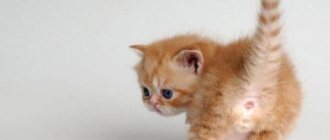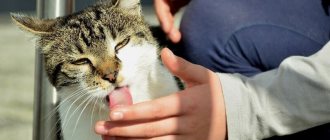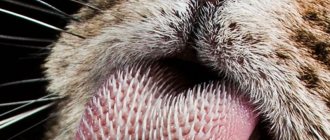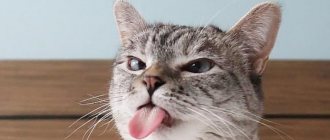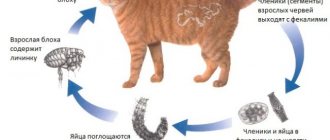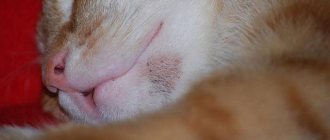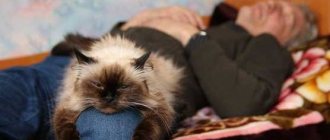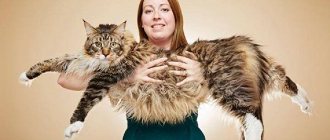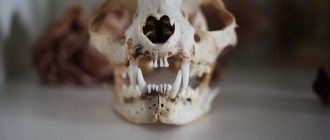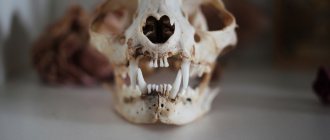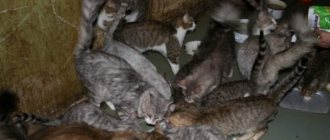Ear flattening as a way to express emotions
Before you worry about the health of a cat that presses its ears to its head, you need to track the situation in which it does this. Perhaps this behavior is just a way of communicating and showing certain emotions. In a number of situations, pets demonstrate their mental and physical state in a similar way:
- Stroking . A cat always presses its ears to its head when being petted - it does this to show maximum pleasure and demonstrate its desire to receive more affection.
- Manifestation of the hunting instinct . Seeing a fly or mosquito, the cat begins to hunt for it. At first, her ears are raised high as a sign of maximum concentration and attention to the object. When approaching a target, the ears will be pressed to the head.
- Protection . When a pet caresses its owner's leg or scratches its head on an object, it will press its ears to its head so as not to touch them.
- Manifestation of fear . In this situation, not only will the ears change their direction, but the cat’s entire posture will be as compact as possible.
- During sleep . By pressing its ears to its head, the cat retains maximum heat inside the body. Pets do this mainly during cold weather.
- Fright . A sharp, irritating sound suddenly heard by a cat will initially frighten it, causing its ears to immediately drop to its head. Only after a second, having calmed down, she will raise her ears, looking for the source of irritation.
- Display of sexual behavior. Unsterilized animals often flatten their ears due to sexual heat, indicating their readiness to reproduce.
You should be wary of a situation when a cat changes the direction of its ears for no apparent reason, and also shakes its head.
Such a symptom may indicate the presence of certain diseases and pathological conditions in the animal.
My cat's ears itch - is this normal?
It is normal for a living creature to scratch its ears. This way the pet cleans them of dirt and foreign particles. He can do this up to several times a day and it will be within normal limits. When does ear scratching cease to be a daily hygiene procedure? It is worth noting that:
- The animal is worried when scratching, the cat shakes its head irritably and actively.
- The pet became nervous and irritable.
- When brushing, the cat purrs or hisses.
- Scratching became more frequent up to 10 times a day.
- Bleeding wounds appeared in or behind the ears.
If several of the listed signs coincide, you should think about visiting a veterinarian.
Pathologies and diseases
Pathological causes of ears pressing to the head:
- Itching of the skin . In this case, pressing the ears is a reaction to ear or subcutaneous mites or fleas. If there is a subcutaneous tick, your pet's ears will often be pinned back. The itching will spread to the face, neck, and entire body.
- Jumps in blood or atmospheric pressure . They usually manifest themselves as a sudden headache.
- Neurological disorders that can cause auditory hallucinations in an animal.
- Painful sensations. Various diseases can provoke attacks of pain. As a rule, the cat also has other accompanying symptoms: it refuses food, stops being active, preferring to lie down most of the time, and changes its behavior.
If the cat has become lethargic, refuses to eat, does not go into the owner’s arms, shakes its head or constantly itches and at the same time presses its ears to its head, this is a reason to contact a veterinarian as soon as possible.
My cat's ears itch - is this normal?
It is normal for a living creature to scratch its ears. This way the pet cleans them of dirt and foreign particles. He can do this up to several times a day and it will be within normal limits. When does ear scratching cease to be a daily hygiene procedure? It is worth noting that:
- The animal is worried when scratching, the cat shakes its head irritably and actively.
- The pet became nervous and irritable.
- When brushing, the cat purrs or hisses.
- Scratching became more frequent up to 10 times a day.
- Bleeding wounds appeared in or behind the ears.
If several of the listed signs coincide, you should think about visiting a veterinarian.
American Curl
A wonderful breed of cats with small ears. The animals are very peaceful, have thick fur, which can be either short or long. The pets are active and love to play, they respond well to training, and can walk on a leash with their owner. They are distinguished by small ears with tassels, which makes cats recognizable.
The nature of the animals is flexible, they get along well with children, are unobtrusive, but enjoy playing with their owner. There is another interesting feature in the structure of a cat's ear. A photo of the animal shows how representatives of this breed have ears that curve outward, making the pets look unusual and even funny.
Outer ear
This part includes:
- Auricle. In most breeds it is erect and straight. But there are animals with hanging, curved ears.
- Auditory canal.
The cartilage of the outer ear is slightly concave, on the outside it is completely covered with hair, on the inside it has delicate skin and long thin hairs.
Ear canal with pink thin tissue. This part contains the sulfur glands. The color of sulfur in cats is not yellow, like in humans, but brown. In healthy animals, these accumulations are practically absent in the canal.
At the end of the ear canal there is a membrane. It is not visible from the outside. It is well protected by the large bend of the channel, thus being practically “around the corner”. Thanks to this, the most important organ is reliably covered and protected from injury.
Ear infection
Why does a cat shake his head from side to side and scratch his ears? It is possible that he has inflammation of the inner, outer or middle ear. This disease may appear due to untreated or severe scabies. Other causes of inflammation:
- sulfur plug;
- hypothermia;
- foreign object in the ear.
Sometimes this disease is provoked by infections. If there is pancreatic or liver dysfunction, the cat may also scratch its ears. Brown pellets are also observed in the shells.
Symptoms of the disease:
- Itching in the ears.
- Uncontrolled head movements.
- Decreased appetite.
- Fluid in the ears.
Features of feeding Scots
Due to the fact that Scots are prone to diseases of the musculoskeletal system, when choosing food for a Scottish cat, it is important to pay attention to the content of vitamin D and calcium. Scottish cats are also prone to weight gain, so you need to monitor how many calories your cat consumes per day.
Important! Food should not be freely available all the time. That is, after each meal the bowl of food is removed.
When deciding to feed an animal natural food, a trip to a veterinary nutritionist is the first thing owners should do.
Diet choice is an important decision for your cat's health.
After sterilization/castration, the animal’s needs change, which means the diet also needs to be changed.
When feeding a natural diet, it is necessary to reduce the number of calories and reduce or completely eliminate foods containing phosphorus and magnesium. Neutered animals are prone to weight gain and kidney disease. Obesity is not good for anyone.
Males themselves are prone to developing urolithiasis (UKD), this does not depend on castration. For prevention, veterinarians advise feeding your pets with specialized dry food. With this diet, the animal drinks more, and the kidneys and bladder are better washed. Also, with the help of food it is easier to control the weight of the animal - just reduce the portion.
Inner ear
In cats, the inner ear (labyrinth) is the deepest part of the entire auditory system. It includes the sensory structures of the apparatus and balance. The ear canal is protected here by the temporal bone. In this ear of cats there is a very important organ of Corti, which converts sounds coming from the eardrum into electrical impulses that are transmitted through neural networks to the brain.
In addition, the vestibular apparatus is located in this area - three semicircular small fluid-filled canals. They contain microscopic hairs. All fluid movements are captured by these bristles, which generate nerve impulses. The brain receives these signals and determines the horizon line, the position of the body, where is up and down and the animal maintains balance.
Thus, in cats, the ears consist of a sound-receiving system and organs that help animals maintain balance during movements.
Owners of such delicate pets should know the structural features of cats' ears in order to properly care for these important organs.
Non-pathological causes
Factors that can cause discomfort in an animal, causing it to lower its ears, sometimes using its paws:
- unpleasant sensations in the ears that arise as a result of cleaning (see the article on how to properly clean a cat’s ears);
- water getting into the ears after bathing (see the article why cats should not get their ears wet).
All this leads to irritating sensations, and the cat, trying to get rid of them, will press its ears to its head for some time.
If you see that your pet's ears are often drooping, there is no need to rush to see a veterinarian. First, you should carefully analyze in what situation he does this. Perhaps such a manifestation is not a sign of illness, but an expression of emotions and feelings by the cat.
Source
Kankalow
This breed was developed almost by accident - Terry Harris from America decided to “create” cats with tiny, short legs. Thus, Curls were crossed with Munchkins. The Kinkalow breed was first registered in 1997 and a standard was recognized. The cat has a strong build, a long tail and ears that are curved slightly back. Short legs are a distinctive feature of these cats.
Ukrainian Levkoy
The Ukrainian Levkoy is an original looking hairless fold cat. The Levkoys contain the blood of Donchak and Orientals (via Peterbalds), and to obtain lop-eared blood, the blood of Scottish Folds was once infused, but indirectly, that is, through a mestizo.
With a slender build, graceful long neck, expressive coordination and folded back ears, these are elves. If we omit the breeding branches and simply say, then Elves are a mixture of curl and sphinx.
Scottish straight
The straight-eared representatives of the Scottish breed were not recognized by the felinological society for a very long time, classifying them as a British breed. It was only in 2004 that the standards were revised, as the straight-eared Scots began to differ markedly from their British ancestors. This is how straight-eared Scots got the name “Scottish Straight”.
The difference between folds and straights is only in the shape of the cat's ears. “Straight” means “straight” and we are talking specifically about the cat’s ears. Scottish Straight ears are larger than Fold ears, straight, but with the same rounded tips. Otherwise, straights and folds are no different from each other.
Choosing the right kitten
The most characteristic feature of the American Curl is the curl on the ears. This is exactly why you need to choose a kitten. The best time for this is when the curl is visible clearly and clearly - and this is 4 months from birth. It is after this time that the wrapping of the ears ends.
It will be immediately noticeable whether he will be a breeding cat, whether your pet is applying for an exhibition or will be a domestic cat:• a domestic cat will have the smallest angle of wrapping (the first degree);• a larger angle or another degree will show you a breeding cat, it is better to keep this one for breeding;• steep a curl or third degree is a manifestation of an exhibition handsome man.
The price of the kitten will depend on this. Ideally, a kitten's ear curl should be in the form of a neat curve, similar to a crescent. It is worth noting that in advance, before the end of the 4-month period, it is almost impossible to determine to what degree the ear will twist. You don’t even have to take the kitten’s relatives; two show kittens can give birth to both a show kitten and a domestic one.
READ Diarrhea after vaccination. Diarrhea in a puppy after vaccination: reasons, what to do
In addition to appearance, you need to pay attention to the pedigree of the little Curl. The price will also depend on who its parents were:• if the kitten does not have a pedigree, then its price will be in the range of 3-10 thousand rubles;• pedigree Curls are valued more - from 10 to 20 thousand;• purebred show kittens will cost to the buyer 25,000 or more.
When purchasing, you should read in detail all the documents for the kitten, and especially look at its behavior. They should be calm and not at all shy.
Prevention of ear canal diseases
The basis of prevention is limiting contact with stray animals. They are the ones who pose the greatest risk of infecting your pet with ticks, fleas or otitis media. Also important:
- Maintain ear canal hygiene. To do this, you can clean them with a cotton swab and a disinfectant, for example, Otodepin drops.
- Wash the animal carefully so that water does not get inside the ear canal.
- Strengthen your four-legged friend's immunity with mineral supplements and a balanced diet.
It is equally important to regularly examine the animal and observe its behavior. If alarming symptoms are detected, you should urgently consult a veterinarian for advice.
As can be seen from the article, a cat does not always scratch its ears because it is sick. If the condition is accompanied by other unpleasant symptoms, and the behavior of your four-legged friend has changed, then this becomes a good reason to contact a veterinarian. With proper treatment, the animal will forget about problems with the ear canal, and compliance with preventive measures will help to avoid them in the future.
Video on the topic
What to do if your cat shakes its head, flattens its ears, or constantly scratches its head. It is clear to any owner that the pet is experiencing discomfort and pain, but how to identify the causes of the disease? Let's look at the main types of diseases that can cause knots, headaches or affect the ears.
If a cat shakes its head frequently or too intensely, there is a reason for this; it may be due to illness or exposure to the external environment. This behavior cannot be left to chance, since many diseases can have irreversible consequences.
The most common reasons why a cat shakes its head is pain or itching. When a pet suffers from itching, the problem is most often localized in the ear area. When a cat scratches its ears with its hind paws, it releases its claws and severely injures the skin. Scratches become swollen and infected, leading to pain.
The conclusion suggests itself - itching is only a symptom, and the true cause of head shaking is always pain.
There is also an option that is not associated with illnesses - this is a foreign body stuck in the ear canal or blocking it
. If you suspect that there is something in your cat's ear, it is strongly recommended that you do not try to treat it at home. By contacting a professional, you can be sure that immobilizing measures will be applied to the animal if the condition threatens to worsen.
If you try to get the object yourself, the pet may jerk and the foreign body will push even deeper. Keep in mind that cats have an L-shaped ear canal, which is also thin and sensitive.
Are you sure there's nothing stuck in your pet's ear? In this case, the cause may be the accumulation of sulfur or disease
. As mentioned above, cats have an L-shaped ear canal, which can make wax plugs invisible. If you haven't cleaned your cats' ears as a preventive measure, it is recommended that you contact your veterinarian. The doctor will clean the pet's ear canals with a special solution that softens the wax and allows it to come out of the ear naturally. Of course, you can do all these procedures yourself, but if the cause of discomfort is not wax plugs, getting liquid into the ear canals is highly undesirable.
